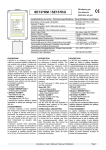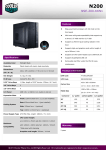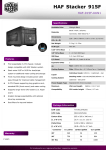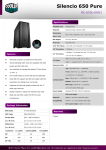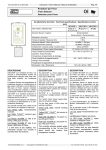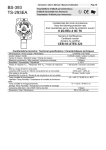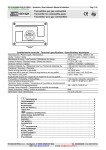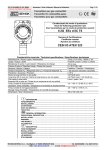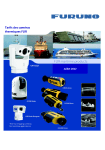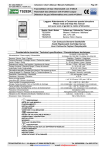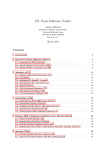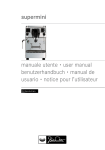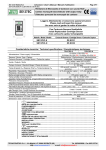Download SE137KM / SE137KG
Transcript
Istruzione / User’s Manual / Manuel d’utilisation IST-2137.KM01.01 (I-137K99) SE137KM / SE137KG Pag.1/4 Rivelatore gas Gas detector Détecteur de gaz Caratteristiche tecniche / Technical specifications / Caractéristiques techniques ALARM 2 ALARM 1 ON FAULT Alimentazione / Power supply / Alimentation Intervento 1° Allarme 1st Alarm intervention / Seuil 1 d'intervention de alarme Intervento 2° Allarme 2nd Alarm intervention / Seuil 2 d'intervention de alarme Uscita / Output / Sortie Sensore / Sensor / Capteur Precisione / Accuracy / Precision Tempo di risposta / Response time / Temps de résponse Deriva a lungo termine in aria pulita Long time drift in pure air / Dérive à long terme en air non pullué Temp./umidità di funzionamento / Operation Temp./Humidity Température et humidité de fonctionnement Temp./umidità di immagazzinamento / Storage Temp./Humidity Température et humidité de stockage Dimensioni / Size / Dimensions DESCRIZIONE L’SE137K è un rivelatore di gas infiammabili con sensore catalitico, costituito da una custodia che contiene il circuito elettronico e i morsetti di collegamento. Il sensore è inserito nel portasensore posto nella parte inferiore della custodia. L’SE137K ha 2 relè d’allarme che intervengono rispettivamente al 10% e al 20% del LIE del gas di taratura. I relè, di tipo sigillato, sono normalmente eccitati con contatti in scambio liberi da tensione. Sul coperchio sono visibili 4 Led che indicano le condizioni di esercizio: Led Verde "ON": funzionamento normale. Led Giallo "SENSOR FAULT": sensore guasto o scollegato. Led Rosso "ALARM 1": relè di allarme (10% LIE). Led Rosso "ALARM 2": relè di allarme (20% LEL CH4). I mod.SE137K vengono utilizzati in sistemi centralizzati di allarme per parcheggi, industrie, ecc. FUNZIONAMENTO Il sensore catalitico è poco sensibile alle variazioni di umidità e temperatura ed è in grado di rilevare molti gas infiammabili. Per questo anche se la taratura viene eseguita per uno specifico gas, può rilevare anche altri gas o solventi infiammabili se presenti nello stesso locale. Il sensore, quando viene alimentato, necessita di un tempo di preriscaldo di circa 30 secondi. Dopo questo tempo è in grado di rilevare il gas, ma raggiunge le condizioni di stabilità ottimali dopo circa 48 ore di funzionamento continuo. TECNOCONTROL S.p.A. DESCRIPTION The SE137K is a flammable gas detector employing a catalytic sensor. The instrument comprises of a plastic enclosure housing the electronic circuit and the connecting terminals; the downward facing cylindrical section houses the sensor. This dual level gas detector has two alarm thresholds set to 10% and 20% LEL. The sealed relays are normally activated with tension free changeover contacts. On the front panel 4 LEDs shows the working conditions: Green LED "ON": normal working condition Yellow LED "SENSOR FAULT": faulty or disconnected sensor. Red LED "ALARM 1": 1st relay activation (10% LEL). Red LED "ALARM 2": 2nd relay activation (20% LEL). The SE 137K find their best application in centralized alarm systems for car parks, manufacturing industries, etc. OPERATIONAL DESCRIPTION Catalytic sensors are almost insensitive to humidity and temperature variations and are designed to detect various flammable gases. Even if the calibration is carried out for a specific gas, they can contemporaneously detect any other flammable gas that should be present in the same enviroment. When powered, the sensor needs a time of preliminary heating of about 30 seconds, but it attains the optimum stability conditions after about 48 hours continual functioning. Via Miglioli 97 SEGRATE ( MI ) 12÷24Vdc (-10/+15%) / 1,5W 10% LIE / LEL 20% LIE / LEL relè / relays / relais 24V / 2A SPDT Catalitico / Catalytic / Catalytique ± 10 % < 60 secondi / seconds / secondes < ± 4 %LIE anno < ± 4 %LEL year / < ± 4 %LIE an -10 ÷ +50 °C / 5÷90 % r.h. 40°C -25 ÷ +55°C / 5÷95 % r.h. 187 x 80 x 67 mm / IP65 DESCRIPTION Le SE137K est un détecteur de gaz inflammables qui utilise un capteur catalytique. L'appareil est constitué d'un boîtier contenant le circuit électronique et les borniers de raccordement. Le capteur est monté dans une tête qui est placé dans la partie inférieure du boîtier. L'appareil possède 2 relais d’alarme qui interviennent respectivement à 10% et à 20% LIE. Les relais de type étanche, sont normalement excités avec contact inverseurs libres de tension. Sur la face avant sont visibles 4 Led qui indiquent les conditions de fonctionnement: LED verte “ON”: fonctionnement normal LED jaune “SENSOR FAULT”: derangement ou capteur déconnecté LED orange “ALARM 1”: 1er relais d’alarme (10% LIE) LED rouge “ALARM 2”: 2e relais d’alarme (20% LIE) Les SE137K sont normalement utilisés dans les systèmes d’alarmes centralisés pour parkings, industries, laboratoires etc. FONCTIONNEMENT Le capteur catalytique est pratiquement insensible aux variations de température et d'humidité et il est capable de détecter plusieurs gaz combustibles. L'étalonnage est effectué pour le gaz à détecter mais, dans le même temps, il peut détécter d’autres gaz combustibles présent dans la pièce. Lorsque le détecteur est alimenté, le capteur a besoin d’un temps de préchauffage d’environ 30 secondes pour être opérationnel, mais les conditions de stabilisation ne seront obtenues qu’après 48 heures de fonctionnement. Tel: 02/26922890 Fax: 02/2133734 Pag.2/4 Istruzione / User’s Manual / Manuel d’utilisation Guasti: In caso di guasto del sensore si illumina il Led giallo “FAULT” e interviene il corrispondente Relè. Questo relè può essere utilizzato per indicare a distanza una situazione di guasto dei sensori o per segnalare mancanza di alimentazione allo strumento. Periodo di funzionamento: L'elem ento sensibile utilizzato in questo rivelatore ha una buona stabilità nel tempo. In condizioni di funzionam ento norm ale in aria pulita la vita del sensore è circa 10 anni dalla data installazione. Verifiche Periodiche: Si consiglia di effettuare la verifica di funzionamento ogni 6 mesi e ogni anno procedere alla ritaratura del circuito con miscela Gas/Aria come indicato a Pag.4. Nota importante: tenere presente che in ambienti particolarmente inquinati o con vapori di sostanze infiammabili (in particolare solventi), può essere necessario effettuare più spesso la verifica e/o la taratura periodica, inoltre la vita utile del sensore può ridursi notevolmente. INSTALLAZIONE I rivelatori vanno installati e posizionati seguendo tutte le norm e nazionali vigenti per gli impianti elettrici nei luoghi con pericolo di esplosione e le norm e di sicurezza degli impianti. Posizionamento L’apparecchio va installato verticale con il sensore rivolto verso il basso, posizionandolo: ? ? a 20-30cm dal soffitto se il gas da rilevare è più leggero dell'aria (es.Metano). ? ? a 20-30cm dal pavimento se il gas da rilevare è più pesante dell'aria (es.GPL). Collegamenti elettrici (Fig.1): la distanza massima cui può essere installato ogni rivelatore dall'alimentatore è di 800m con cavo da 1,5mm 2 e di 1400m con cavo da 2,5mm 2 a 12 Vcc, mentre è di 7500m con cavo da 1,5mm 2 e di 13000m con cavo da 2,5mm 2 a 24 Vcc. Non serve utilizzare cavi schermati. Nel caso di alimentazione di più apparecchi in parallelo, è necessario tener conto della caduta di tensione sui tratti comuni dei cavi. I morsetti sono del tipo ad innesto, è necessario sfilarli per effettuare i collegamenti. Prestare attenzione nel reinserirli dato che sono polarizzati. I relè, di tipo sigillato, sono normalmente eccitati con contatti in scambio liberi da tensione per cui se manca l’alimentazione si spostano automaticamente in posizione di allarme. TECNOCONTROL S.p.A. Faults: When a sensor fault occurs, the yellow LED “FAULT” illuminates and the corresponding relay activates. If necessary, the "FAULT" relay, can be used both to remotely indicate a damage being occured or to indicate the absence of power to the instrument. Average life: The sensitive element used in this detector has an exellent stability in time. In fresh air and in normal working condition the sensor's life is about 10 years from the date of installation. Periodical testing: we advise to carry out working tests every six months. After 1 year we advise to proceed to the recalibration of the circuit with Gas/Air mixture as explained on page 4. Attention: in polluted environments, where vapours of flammable agents, especially solvents, might be present, the periodical testings and recalibrations should be carried out at shorter time intervals. In polluted environments the sensor's life can be reduced. INSTALLATION The detector must be accurately installed according to the national dispositions in force on the safety of the plants and installation of electric devices in areas with danger of explosion. Positioning: The unit must be positioned vertically with the sensor downwards. The detector should be installed: ? ?at 20-30 cm below the ceiling if the gas to be detected is lighter than air (ex., Methane). ? ?at 20-30 cm from the floor if the gas to be detected is heavier than air (ex., LPG). Electric connections (see Fig.1): the maximum distance to install each detector from the power supply is 800m with a 1,5mm 2 cable and 1400m with a 2,5 mm 2 cable at 12 Vdc, whereas is 7500m with a 1,5mm 2 cable and 13000m with a 2,5 cable at 24 Vdc. It is not necessary to use shielded cables. If more than one detector is to be powered in parallel, it is necessary to consider the voltage drop across the supply cable. Terminals are plug-in type: it is necessary to extract them to make any connections. Pay attention when you insert them again, being polarized. The sealed relays are normally activated with tension free changeover contacts, if a power supply interruption occur, they automatically deactivate. Via Miglioli 97 SEGRATE ( MI ) IST-2137.KM01.01 Dérangement: En cas de panne du capteur la LED jaune “FAULT” s'illumine et le relais de dérangement s'active. Ce relais est aussi destiné à la signalisation à distance d'un dérangement ou d'une coupure d'alimentation. Vie moyenne: Le capteur a une excellente stabilité dans le temps. En condition de fonctionnement normale en air non pollué, la vie utile du capteur est d'environ 10 ans à partir de la date de mise sous tension. Verification périodique: Il est conseillé d'effectuer une vérification de fonctionnement après 6 mois, et pendant l’année de procéder au réétalonnage du circuit avec une mélange gaz/air, répertorié en page 4. Attention: En milieu particulièrement pollué, avec présence de vapeurs inflammables et en particulier de solvants, il peut être nécessaire d'augmenter la fréquence des temps de vérification et d'étalonnage. En outre, la vie du capteur peut être réduite. INSTALLATION Les détecteurs doivent être installés selon les normes en vigueur pour les installations électriques dans les locaux avec danger d'explosion et les normes de sécurité des installations. Positionnement: le SE137K doit être installé en position verticale et le capteur doit être tourné vers le bas. Le détecteur doit être installé: ? ?à une hauteur de 20÷30 centimètres du plafond si le gaz à détecter est plus léger que l’air (ex. méthane) ? ?à 20÷30 centimètres du plancher si le gaz à détecter est plus lourd que l’air (ex. GPL). Raccordements électriques (Fig.1): La distance maximale à laquelle peut être raccordé le SE137K avec alimentation en12Vcc est de 800m avec câble 1,5mm 2 et 1400m avec 2 câble 2,5mm . Avec alimentation en 24Vcc de 7500m avec câble 1,5mm 2 et 13000m avec câble 2,5mm 2 Si l’on a l’alimentation de plusieurs appareils en parallèle, il faudra considérer la chute de tension sur les cables. Les borniers sont de type débrochables polarisés et pour effectuer les connexions il faut les débrocher. Les relais sont normalement excités avec contact inverseurs libres de tension. Tel: 02/26922890 Fax: 02/2133734 IST-2137.KM01.01 Istruzione / User’s Manual / Manuel d’utilisation Il relè “ALARM 2” è ritardato di circa 40 secondi. Il ritardo può essere eliminato, sfilando il ponticello “JP1” sul circuito stampato come indicato in figura 3. AVVERTENZE Attenzione: Alcune sostanze causano una diminuzione permanente di sensibilità. Evitare che il sensore venga a contatto con vapori di Silicone, Tetraetile di Piombo o Esteri fosfati. Altre sostanze causano una temporanea perdita di sensibilità. Questi “inibitori” sono gli Alogeni, l’Idrogeno solforato, il Cloro, gli Idrocarburi clorurati (Trielina o Tetracloruro di carbonio). Dopo un breve tempo in aria pulita, il sensore riprende il proprio funzionamento normale. Importante: Il sensore catalitico funziona solo in presenza di Ossigeno. Non usare gas puri o l'accendino direttamente sul sensore che potrebbe venire irrimediabilmente danneggiato. Note sui vari modelli SE137KG (GPL) L’SE137KG è in grado di rivelare GPL. Il GPL è un gas più pesante dell'aria, formato da una miscela composta dal 20÷30% di Propano (C3H8) e dall'80÷70% di Butano (C4H10). La densità relativa all'aria è 1,56 per il Propano e 2 per il Butano; il LIE (Limite Inferiore di Esplosività) è 2% v/v per il Propano e 1,5% v/v per il Butano. Le tarature per GPL sono normalmente effettuate con gas Butano. SE137KM (Metano CH4) L’SE137KM è in grado di rivelare Metano. Il Metano è un gas combustibile più leggero dell'aria. La sua densità relativa all'aria è 0,55 ed il suo LIE è 5%v/v (%Volume). TARATURA La verifica e/o taratura del SE137K può essere eseguita con il tester di calibrazione Tecnocontrol (mod. TC011). Importante: è possibile utilizzare sia le bombole monouso da un litro che quelle ad alta pressione con riduttore con miscela Gas al 10%LIE (ALARM 1) e al 20%LIE (ALARM 2) in aria 20,9% Ossigeno, in quanto i sensori catalitici non possono funzionare in assenza di ossigeno. Nota: La taratura è effettuata con gas calibrato. La verifica periodica e/o la taratura in campo deve essere effettuata solo da personale addestrato e autorizzato. In alternativa, si consiglia di effettuare solo la verifica senza toccare i trimmer e nel caso i valori non siano quelli richiesti contattare il nostro laboratorio. TECNOCONTROL S.p.A. The second relay intervention is retared by almost 40 seconds. To remove the delay, remove the jumper “JP1” on the PCB as shown in the figure 3. WARNING Warning: Some substances cause a permanent reduction in sensitivity. Avoid contacts of the sensor with vapours of Silicone compunds, Tetra-ethyl Lead and Phosphate esters Some other substances produce a temporary loss of sensitivity. These “inhibitors” include Hidrogen sulfide, Chlorine, Chlorinated hydrocarbons and halohenated compounds. The sensitivity is recovered after a short period of running in clear air. Important: The catalytic sensor operate only in presence of Oxygen. Do not use pure gases or a lighter directly on the sensor since they could damage it irremediabily. Notes on the available Models SE137KG (LPG) Model SE137KG is calibrated to detect LPG. This gas is heavier than air and consists of a mixture of 2030% Propane (C3H 8) and 80-70% Butane (C4H 10). Propane density as to air is 1.56 while Butane' is 2. The LEL (Lower Explosivity Limit) is 2%v/v for Propane and 1,5%v/v for Butane. Standard calibration to LPG is carried out with Butane gas. SE137KM (Methane CH4) Model SE137KM is calibrated to Methane. Methane is a gas lighter than air, its density as to air is 0.55, and its LEL 5%v/v (%volume). CALIBRATION The SE137K calibration and /or verification should be carried out by using the Tecnocontrol calibration kit (Model TC011). Very Important note: Both high pressure sample gas bottles with reducer and 1 litre gas bottles may be employed. Use sample bottles with a gas mixture of 10% LEL (Alarm 1) and 20% LEL (Alarm 2) in Air 20.9% Oxygen, as catalytic sensors don’t work without Oxygen. Note: Calibration is carried out with sample gas. The calibration rutine is to be carried out by trained or authorised personnell only. As an alternative it is advised to check the calibration without operating on the trimmers, and in case the values are not the required ones please apply to our Laboratory. Via Miglioli 97 SEGRATE ( MI ) Pag.3/4 L’intervention du 2e relais “ALARM 2” est retardée d’environ 40 secondes. Ce rétard peut être eliminé en enlévant le cavalier “JP1” sur le circuit imprimé, comme indiqué dans la figure 3. AVERTISSEMENT Attention: Eviter que le capteur vienne au contact de vapeurs de silicone, plomb tétraéthyle ou hydrocarbures chlorés, ces substances pouvant en réduire irréversiblement la sensibilité. Le contact occasionnel avec des solvants type trichloréthylène ou tétrachlorure de carbone peuvent inhiber temporairement le capteur. Après un bref temps en air pur le capteur reprend son fonctionnement normal. Attention: Les capteurs catalytiques fonctionnent seulement en présence d’Oxygène. Eviter l'usage de gaz pur ou du briquet sur le capteur, qui pourrait être irrémédiablement endommagé. Les modèles SE137KG (GPL) Le SE137KG permet de détecter le GPL. Le GPL est un gaz plus lourd que l'air, formé d'un mélange composé de 20-30% de Propane (C3H8) et de 70-80% de Butane (C4H10). La densité relative à l'air est 1,56 pour le Propane et 2 pour le Butane. La LIE (limite inférieure d'explosivité) du Propane est 2% v/v et celle-ci du Butane est 1,5% v/v. Tous les étalonnages pour GPL sont fait avec du Butane. SE137KM (Methane CH4) Le SE 137K perm et de détecter le Méthane. Le Méthane est un gaz plus léger que l'air. Sa densité par rapport à l'air est 0,55, sa LIE est 5%v/v (% volum e). ETALONNAGE Il est possible de vérifier et étalonner le SE137K avec le Kit d’etalonnage Tecnocontrol. (Mod. TC011). Attention: il est possible d’utiliser soit la bouteille de 1 litre, soit une bouteille à haute pression avec réducteur, avec m élange Gaz 10%LIE et 20%LIE en air (O2= 20,9%). Les capteurs catalytiques ne fonctionnent pas en absence d’oxygène. Attention: L'étalonnage est effectué avec du gaz étalon. L'étalonnage doit être effectué seulement par le personel autorisé. Dans le cas contraire il est conseillé de vérifier le calibrage sans toucher les potentiomètres et dans le cas où les valeurs ne sont pas correctes, veuillez prendre contact avec notre Laboratoire. Tel: 02/26922890 Fax: 02/2133734 Pag.4/4 Istruzione / User’s Manual / Manuel d’utilisation Per la regolazione del trimmer è necessario utilizzare un cacciavite a taglio di dimensione adeguata Aprire il coperchio della custodia. “Regolazione dell’ALLARME 1”. Per verificare e/o tarare lo strumento va utilizzata la bombola con la stessa miscela Gas/aria al 10% LIE per cui è stato tarato il rivelatore. Collegare la bombola al Flussimetro (Fig.4); far affluire il gas a circa 0,15÷0,3 l/min, attendere circa 3 minuti e verificare che si illumini il Led Rosso “ALARM 1”. Se così non fosse ruotare lentamente il Trimmer “P1” (Fig.3) fino all’accensione del Led “ALARM 1”. “Regolazione dell’ALLARME 2”con la stessa miscela Gas/aria al 20%LIE per cui è stato tarato il rivelatore, collegare la bombola al Flussimetro (Fig.4), far affluire il gas a circa 0,15÷0,3 l/min, attendere circa 3 minuti e verificare che si illumini il Led Rosso “ALARM2”. Se così non fosse ruotare lentamente il Trimmer “P2” (Fig.3) fino all’accensione del Led “ALARM 2”. C NA NC C Pour le réglage du potentiomètre il est nécessaire d’utiliser un tournevis de dimension adaptée. Ouvrir le couvercle du boîtier. “Réglage d’ALARM 1”. Pour l'étalonnage utiliser une bouteille avec le mélange spécifique gaz 10%LIE/air utilisé pour la calibration de l’appareil. Raccorder la bouteille au débimètre (Fig 4) faire débiter le gaz à environ 0,150,3 l/min, attendre 3 minutes et vérifier que la LED rouge “ALARM 1” s’illumine. Si nécéssaire, régler le potentiomètre “P1” jusqu’à l’allumage de la LED (Fig.3). “Réglage d’ALARM 2”: pour l'étalonnage utiliser une bouteille avec le mélange spécifique gaz 20%LIE/air utilisé pour la calibration de l’appareil. Raccorder la bouteille au debimètre (Fig 4) faire débiter le gaz à environ 0,150,3 l/min, attendre 3 minutes puis vèrifier que la LED rouge “ALARM 2” s’illumine. Si nécéssaire, régler le potentiomètre “P2” jusqu’à l’allumage de la LED (Fig.3). AL2 AL1 NA NC C FAULT NC NA 12÷24Vdc Employ a right sized single slot screwdriver to operate on the trimmer. Remove the sensor's cover. “ALARM 1 calibration”. To verify or/and calibrate the instrument use a sample bottle with the same 10%LEL specific gas/air mixture which had been used to calibrate the unit. Connect the sample gas bottle (Fig.4) to the flowmeter, set the flowmeter on a 0,15÷0,3 l/min flow rate, wait for 3 minutes and verify the red LED “ALARM 1” illuminates. If necessary slowly turn the “P1” potentiometer as long as the red LED “ALARM 1”illuminates (See fig.3). “ALARM 2 calibration”. Use a sample bottle with the same 20%LEL specific gas/air mixture which had been used to calibrate the unit. Connect the sample gas bottle (Fig.4) to the flowmeter, set the flowmeter on a 0,15÷0,3 l/min flow rate, wait for 3 minutes and verify the red LED “ALARM 2” illuminates. If necessary slowly turn the “P2” potentiometer as long as the red LED “ALARM 2” illuminates (See fig.3). IST-2137.KM01.01 + Fig. 1 Schema di collegamento Wiring diagram L 4 / Schéma Fig. 2 Dimensioni Outline Dimensions / Dimensions 230V-50Hz JUMPER / CAVALIER 0,3L/min JP1 P2 “ALARM 2” P1 “ALARM 1” Fig.3 Verifica / Test / Vérification TECNOCONTROL S.p.A. Via Miglioli 97 SEGRATE ( MI ) Fig.4 Tester di calibrazione Calibration Tester Kit de Calibration Tel: 02/26922890 Fax: 02/2133734




